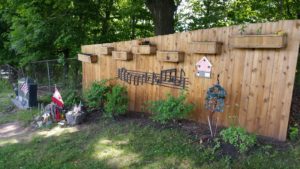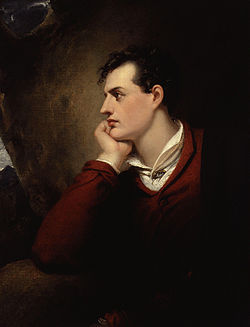
Portrait by Richard Westall
On this day in 1824, poet and eading figure in the Romantic movement, Lord Byron died at the age of 36 in Missolonghi, Aetolia-Acarnania,Ottoman Empire (Greece). Born George Gordon Byron on 22 January 1788 in a house on 24 Holles Street in London. In my opinion, Byron is one of the greatest British poets, and remains widely read and influential. He travelled widely across Europe, especially in Italy where he lived for seven years. Later in life, Byron joined the Greek War of Independence fighting the Ottoman Empire, for which many Greeks revere him as a national hero. Often described as the most flamboyant and notorious of the major Romantics, Byron was both celebrated and castigated in life for his aristocratic excesses, including huge debts, numerous love affairs, rumours of a scandalous liaison with his half-sister, and self-imposed exile. He also fathered the Countess Ada Lovelace, whose work on Charles Babbage’s Analytical Engine is considered a founding document in the field of computer science. Perhaps his best known works are the lengthy narrative poems Don Juan and Childe Harold’s Pilgrimage and the short lyric She Walks in Beauty.
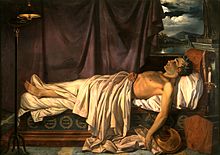
Lord Byron On His Deathbed by Joseph Denis Odevaere
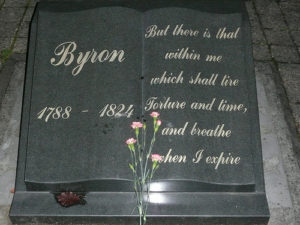 The Final Footprint – Alfred, Lord Tennyson would later recall the shocked reaction in Britain when word was received of Byron’s death. The Greeks mourned Lord Byron deeply. The national poet of Greece, Dionysios Solomos, wrote a poem about the unexpected loss, named To the Death of Lord Byron. Βύρων (“Vyron”), the Greek form of “Byron”, continues in popularity as a masculine name in Greece, and a town near Athens is called Vyronas in his honour. Byron’s body was embalmed, but the Greeks wanted some part of their hero to stay with them. According to some sources, his heart remained at Missolonghi. His other remains were sent to England (accompanied by his faithful manservant, “Tita”) for burial in Westminster Abbey, but the Abbey refused for reason of “questionable morality”. Huge crowds viewed his body as he lay in state for two days in London. He is buried at the Church of St. Mary Magdalene in Hucknall, Nottinghamshire. A marble slab given by the King of Greece is laid directly above Byron’s grave. A duplicate of the slab was later placed in Westminster Abbey. His daughter, Ada Lovelace, was later buried beside him. Byron’s friends raised the sum of 1,000 pounds to commission a statue of the writer; Thorvaldsen offered to sculpt it for that amount. However, for ten years after the statue was completed in 1834, most British institutions turned it down, and it remained in storage. The statue was refused by the British Museum, St. Paul’s Cathedral, Westminster Abbey and the National Gallery before Trinity College, Cambridge, finally placed the statue of Byron in its library. In 1969, 145 years after Byron’s death, a memorial to him was finally placed in Westminster Abbey. The memorial had been lobbied for since 1907: The New York Times wrote, “People are beginning to ask whether this ignoring of Byron is not a thing of which England should be ashamed … a bust or a tablet might be put in the Poets’ Corner and England be relieved of ingratitude toward one of her really great sons.”. Robert Ripley had drawn a picture of Boatswain’s grave with the caption “Lord Byron’s dog has a magnificent tomb while Lord Byron himself has none”. This came as a shock to the English, particularly schoolchildren, who, Ripley said, raised funds of their own accord to provide the poet with a suitable memorial. Close to the centre of Athens, Greece, outside the National Garden, is a statue depicting Greece in the form of a woman crowning Byron. The statue is by the French sculptors Henri-Michel Chapu and Alexandre Falguière.
The Final Footprint – Alfred, Lord Tennyson would later recall the shocked reaction in Britain when word was received of Byron’s death. The Greeks mourned Lord Byron deeply. The national poet of Greece, Dionysios Solomos, wrote a poem about the unexpected loss, named To the Death of Lord Byron. Βύρων (“Vyron”), the Greek form of “Byron”, continues in popularity as a masculine name in Greece, and a town near Athens is called Vyronas in his honour. Byron’s body was embalmed, but the Greeks wanted some part of their hero to stay with them. According to some sources, his heart remained at Missolonghi. His other remains were sent to England (accompanied by his faithful manservant, “Tita”) for burial in Westminster Abbey, but the Abbey refused for reason of “questionable morality”. Huge crowds viewed his body as he lay in state for two days in London. He is buried at the Church of St. Mary Magdalene in Hucknall, Nottinghamshire. A marble slab given by the King of Greece is laid directly above Byron’s grave. A duplicate of the slab was later placed in Westminster Abbey. His daughter, Ada Lovelace, was later buried beside him. Byron’s friends raised the sum of 1,000 pounds to commission a statue of the writer; Thorvaldsen offered to sculpt it for that amount. However, for ten years after the statue was completed in 1834, most British institutions turned it down, and it remained in storage. The statue was refused by the British Museum, St. Paul’s Cathedral, Westminster Abbey and the National Gallery before Trinity College, Cambridge, finally placed the statue of Byron in its library. In 1969, 145 years after Byron’s death, a memorial to him was finally placed in Westminster Abbey. The memorial had been lobbied for since 1907: The New York Times wrote, “People are beginning to ask whether this ignoring of Byron is not a thing of which England should be ashamed … a bust or a tablet might be put in the Poets’ Corner and England be relieved of ingratitude toward one of her really great sons.”. Robert Ripley had drawn a picture of Boatswain’s grave with the caption “Lord Byron’s dog has a magnificent tomb while Lord Byron himself has none”. This came as a shock to the English, particularly schoolchildren, who, Ripley said, raised funds of their own accord to provide the poet with a suitable memorial. Close to the centre of Athens, Greece, outside the National Garden, is a statue depicting Greece in the form of a woman crowning Byron. The statue is by the French sculptors Henri-Michel Chapu and Alexandre Falguière.
| Dame Daphne du Maurier DBE | |
|---|---|
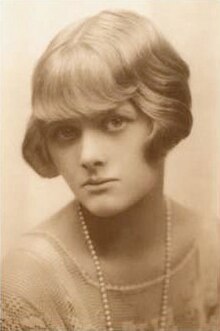 (about 1930) |
|
On this day in 1989 author and playwright Daphne du Maurier died, aged 81, at her home in Cornwall. Born on May 1907 in London.
Although she is classed as a romantic novelist, her stories seldom feature a conventional happy ending and have been described as “moody and resonant” with overtones of the paranormal. These bestselling works were not at first taken seriously by critics, but have since earned an enduring reputation for storytelling craft. Many have been successfully adapted into films, including the novels Rebecca, My Cousin Rachel, and Jamaica Inn, and the short stories “The Birds” and “Don’t Look Now/Not After Midnight”.
Du Maurier spent much of her life in Cornwall, where most of her works are set. As her fame increased, she became more reclusive.
Du Maurier married Major (later Lieutenant-General) Frederick “Boy” Browning in 1932. Biographers have noted that du Maurier’s marriage was at times somewhat chilly and that she could be aloof and distant to her children, especially the girls, when immersed in her writing. Her husband died in 1965 and soon after Daphne moved to Kilmarth, near Par, Cornwall, which became the setting for The House on the Strand.
After her death in 1989, references were made to her reputed bisexuality; an alleged affair with Gertrude Lawrence, as well as her attraction to Ellen Doubleday, the wife of her U.S. publisher Nelson Doubleday, were cited. The Daphne du Maurier Companion, edited by Helen Taylor, includes Taylor’s claims that du Maurier confessed to her in 1965 that she had had an incestuous relationship with her father and that he had been a violent alcoholic.
In correspondence that her family released to biographer Margaret Forster, du Maurier explained to a trusted few people her own unique slant on her sexuality: her personality comprised two distinct people – the loving wife and mother (the side she showed to the world); and the lover (a decidedly male energy) hidden from virtually everyone and the power behind her artistic creativity. According to Forster’s biography, du Maurier believed the male energy propelled her writing. Forster wrote that du Maurier’s denial of her bisexuality unveiled a “homophobic” fear of her true nature.
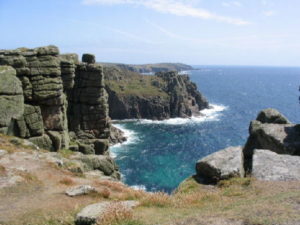
The Final Footprint
Her body was cremated and her ashes scattered off the cliffs at Fowey, Kilmarth, Cornwall.
 On this day in 1995, Timothy McVeigh parked a rental truck filled with explosives in front of the Alfred P. Murrah Federal Building in Oklahoma City. The resulting explosion killed 168 people and destroyed the entire north face of the building. The Oklahoma City National Memorial is a memorial that honors the victims, survivors, rescuers, and all who were changed by the Oklahoma City bombing. The memorial is located in downtown Oklahoma City on the former site of the Alfred P. Murrah Federal Building.
On this day in 1995, Timothy McVeigh parked a rental truck filled with explosives in front of the Alfred P. Murrah Federal Building in Oklahoma City. The resulting explosion killed 168 people and destroyed the entire north face of the building. The Oklahoma City National Memorial is a memorial that honors the victims, survivors, rescuers, and all who were changed by the Oklahoma City bombing. The memorial is located in downtown Oklahoma City on the former site of the Alfred P. Murrah Federal Building.
The Final Footprint – The 3.3 acre memorial can be visited 24 hours a day, 365 days a year and includes;
- The Gates of Time: Monumental twin bronze gates frame the moment of destruction – 9:02 – and mark the formal entrances to the Outdoor Memorial. 9:01, found on the eastern gate, represents the last moments of peace, while its opposite on the western gate, 9:03, represents the first moments of recovery. Both time stamps are inscribed on the interior of the monument, facing each other and the Reflecting Pool. The outside of each gate bears this inscription: We come here to remember Those who were killed, those who survived and those changed forever. May all who leave here know the impact of violence. May this memorial offer comfort, strength, peace, hope and serenity.
- Reflecting Pool: A thin layer of water flows over polished black granite to form the pool.
 Field of Empty Chairs: 168 empty chairs hand-crafted from glass, bronze, and stone represent those who lost their lives, with a name etched in the glass base of each. The chairs represent the empty chairs at the dinner tables of the victims’ families. Three unborn children died along with their mothers, and they are listed on their mothers’ chairs beneath their mothers’ names.
Field of Empty Chairs: 168 empty chairs hand-crafted from glass, bronze, and stone represent those who lost their lives, with a name etched in the glass base of each. The chairs represent the empty chairs at the dinner tables of the victims’ families. Three unborn children died along with their mothers, and they are listed on their mothers’ chairs beneath their mothers’ names.- Survivors’ Wall: The only remaining original portions of the Murrah Building are the southeast corner, known as the Survivors’ Wall, and a portion of the south wall. The Survivors’ Wall includes several panels of granite salvaged from the Murrah Building itself, inscribed with the names of more than 600 survivors from the building and the surrounding area, many of whom were injured in the blast.
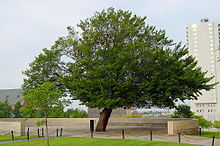 The Survivor Tree: An American elm on the north side of the Memorial, this was the only shade tree in the parking lot across the street from the Murrah Building. The force of the blast ripped most of the branches from the Survivor Tree. Glass and debris were embedded in its trunk and fire from the cars parked beneath it blackened what was left. Most thought the tree could not survive. Almost a year after the bombing, family members, survivors and rescue workers gathered for a memorial ceremony by the tree noticed it was beginning to bloom again. The inscription around the inside of the deck wall around the Survivor Tree reads: The spirit of this city and this nation will not be defeated; our deeply rooted faith sustains us. Hundreds of seeds from the Survivor Tree are planted annually and the resulting saplings are distributed each year on the anniversary of the bombing. Thousands of Survivor Trees are growing in public and private places all over the United States.
The Survivor Tree: An American elm on the north side of the Memorial, this was the only shade tree in the parking lot across the street from the Murrah Building. The force of the blast ripped most of the branches from the Survivor Tree. Glass and debris were embedded in its trunk and fire from the cars parked beneath it blackened what was left. Most thought the tree could not survive. Almost a year after the bombing, family members, survivors and rescue workers gathered for a memorial ceremony by the tree noticed it was beginning to bloom again. The inscription around the inside of the deck wall around the Survivor Tree reads: The spirit of this city and this nation will not be defeated; our deeply rooted faith sustains us. Hundreds of seeds from the Survivor Tree are planted annually and the resulting saplings are distributed each year on the anniversary of the bombing. Thousands of Survivor Trees are growing in public and private places all over the United States.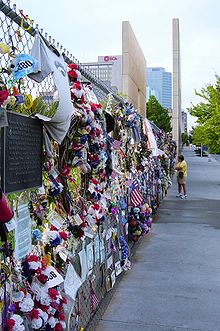 The Memorial Fence: A 10-foot-tall chain link fence was installed around the area that is now the Reflecting Pool and the Field of Empty Chairs to protect the site from damage and visitors from injury. The Fence stood for more than four years, becoming notable as the place where visitors left tributes. Visitors may still leave small items along and in the Fence; the mementos are periodically collected, cataloged, and stored.
The Memorial Fence: A 10-foot-tall chain link fence was installed around the area that is now the Reflecting Pool and the Field of Empty Chairs to protect the site from damage and visitors from injury. The Fence stood for more than four years, becoming notable as the place where visitors left tributes. Visitors may still leave small items along and in the Fence; the mementos are periodically collected, cataloged, and stored.- Rescuers’ Orchard: A grove of Oklahoma redbuds (Oklahoma’s state tree), Amur Maple, Chinese Pistache, and Bosque Elm trees are planted on the lawn around the Survivor Tree.
- Children’s Area: More than 5,000 hand-painted tiles, from all over the United States and Canada, were made by children and sent to Oklahoma City after the bombing in 1995. Most are stored in the Memorial’s Archives, and a sampling of tiles is on the wall in the Children’s Area. Chalkboards provide a place where children can draw and share their feelings. The Children’s Area is north of the 9:03 gate, on the west side of the Museum.
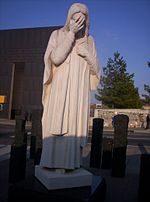 And Jesus Wept: On a corner adjacent to the memorial is a sculpture of Jesus weeping, erected by St. Joseph’s Catholic Church. St. Joseph’s, one of the first brick-and-mortar churches built in the city, was almost destroyed by the blast. Not officially part of the memorial, the statue is regularly visited.
And Jesus Wept: On a corner adjacent to the memorial is a sculpture of Jesus weeping, erected by St. Joseph’s Catholic Church. St. Joseph’s, one of the first brick-and-mortar churches built in the city, was almost destroyed by the blast. Not officially part of the memorial, the statue is regularly visited.- Journal Record Building: North of the memorial is the Journal Record Building, which formerly housed the offices of the The Journal Record. It now houses the Oklahoma City National Memorial Museum, which features numerous exhibits and artifacts related to the Oklahoma City bombing. Staff of the National Memorial Institute for the Prevention of Terrorism, a non-partisan think tank created shortly after the bombing by family members and survivors, also work here to spread knowledge of terrorism and its prevention.
- Alfred P. Murrah Federal Building Plaza: Located just south of the Field of Empty Chairs, above the underground parking garage, is the raised Alfred P. Murrah Federal Building Plaza. An original part of the federal building, the plaza had a garden and seating areas, as well as a playground for the daycare center. Visitors to the Memorial can walk across the plaza, where the original flagpole is used for the American flag.
#RIP #OTD in 1998 poet (Piedra de Sol, essay El laberinto de la soledad), diplomat Octavio Paz died of cancer in Mexico City, aged 84. Antiguo Colegio de San Ildefonso, Centro, Cuauhtémoc Borough, Distrito Federal, Mexico.
| Levon Helm | |
|---|---|
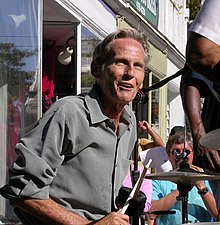 performing in 2004 on the Village Green in Woodstock, New York |
|
On this day in 2012, musician, drummer, actor Levon Helm died from throat cancer at Memorial Sloan-Kettering Cancer Center in New York City at the age of 71. Born Mark Lavon Helm on May 26, 1940 in Elaine, Arkansas. Perhaps best known as the drummer and one of the vocalists for The Band. Helm was known for his soulful, country-accented voice, multi-instrumental ability, and creative drumming style, highlighted on many of the Band’s recordings, such as “The Weight”, “Up on Cripple Creek”, and “The Night They Drove Old Dixie Down”.
Helm also had a successful career as a film actor, appearing as Loretta Lynn’s father in Coal Miner’s Daughter, as Chuck Yeager’s friend and colleague Captain Jack Ridley in The Right Stuff, and as a Tennessee firearms expert in Shooter.
In 1998, Helm was diagnosed with throat cancer, which caused him to lose his singing voice. After treatment, his cancer eventually went into remission, and he gradually regained the use of his voice. His 2007 comeback album Dirt Farmer earned the Grammy Award for Best Traditional Folk Album in February 2008. In 2010, Electric Dirt, his 2009 follow-up to Dirt Farmer, won the first Grammy Award for Best Americana Album, a category inaugurated in 2010. In 2011, his live album Ramble at the Ryman won the Grammy in the same category. On April 17, 2012, his wife and daughter announced on Helm’s website that he was “in the final stages of his battle with cancer” and thanked fans while requesting prayers. Two days later, Helm died from throat cancer at Memorial Sloan-Kettering Cancer Center in New York City at the age of 72.
Helm met singer-songwriter Libby Titus in April 1969, while the Band was recording its second album.
Helm met his future wife, Sandra Dodd, in 1975 in California, while he was still involved with Titus. Helm and Dodd were married on September 7, 1981.
The Final Footprint
On April 17, 2012, Helm’s wife Sandy and daughter Amy revealed that he had end-stage throat cancer. They posted the following message on Helm’s website:
- “Dear Friends,
- Levon is in the final stages of his battle with cancer. Please send your prayers and love to him as he makes his way through this part of his journey.
- Thank you fans and music lovers who have made his life so filled with joy and celebration… he has loved nothing more than to play, to fill the room up with music, lay down the back beat, and make the people dance! He did it every time he took the stage…
- We appreciate all the love and support and concern.
- From his daughter Amy, and wife Sandy”
Fans were invited to a public wake at Helm’s Barn studio complex on April 26. Approximately 2,000 fans came to pay their respects to the rock icon. The following day, after a private funeral service and a procession through the streets of Woodstock, Helm was interred in the Woodstock Cemetery, within sight of the grave of his longtime bandmate and friend Rick Danko.
On the day of Helm’s death, April 19, 2012, Tom Petty & the Heartbreakers, in a concert at the First Bank Center in Broomfield, Colorado, paid tribute to Levon by performing their song “The Best of Everything” and dedicating it to him.
At a concert on May 2, 2012, at the Prudential Center in Newark, NJ, Bruce Springsteen and the E Street Band performed “The Weight” as a tribute to Helm. Springsteen called Helm “one of the greatest, greatest voices in country, rockabilly and rock ‘n’ roll … staggering … while playing the drums. Both his voice and his drumming were so incredibly personal. He had a feel on the drums that comes out of certain place in the past and you can’t replicate it.”
On June 2, 2012, at Mountain Jam, Gov’t Mule, along with the Levon Helm Band (with Lukas Nelson coming on stage for the closing song) played a tribute set, including “The Night They Drove Old Dixie Down,” “Up on Cripple Creek,””It Makes No Difference,” and closing with “The Weight.”
A tribute concert called Love for Levon took place at the Izod Center in East Rutherford, New Jersey, on October 3, 2012. The concert featured many special guests who had collaborated with and were inspired by Helm and the Band, including Roger Waters, Garth Hudson, Joe Walsh, Gregg Allman, Bruce Hornsby, Jorma Kaukonen, John Mayer, Mavis Staples, My Morning Jacket, Marc Cohn, John Hiatt, Allen Toussaint, Jakob Dylan, Mike Gordon and others. Proceeds from the concert were to “help support the lasting legacy of Levon Helm by helping his estate keep ownership of his home, barn and studio, and to continue the Midnight Ramble Sessions.”
At the 2013 Grammy Awards, the Zac Brown Band, Mumford & Sons, Elton John, Mavis Staples, T-Bone Burnett and Alabama Shakes singer Brittany Howard performed “The Weight” as a tribute to Levon and other recently deceased musicians. They also dedicated the song to the victims of the Sandy Hook Elementary School shooting. In May 2013, the New York State Legislature approved a resolution to name State Route 375—the road which connects State Route 28 with the town of Woodstock—”Levon Helm Memorial Boulevard”. Governor Andrew Cuomo signed the bill on June 20, 2013. In July 2017, U.S. 49 from Marvell, Arkansas to Helena-West Helena was named The Levon Helm Memorial Highway by Act 810 of the Arkansas State Legislature. The Levon Helm Legacy Project is raising money to commission a bronze bust of Helm and to restore his boyhood home. The house, originally located in Turkey Scratch, Arkansas, was moved in 2015 to Marvell, where Helm attended school.
#RIP #OTD in 2021 composer, lyricist (Meat Loaf’s Bat Out of Hell album, “Total Eclipse of the Heart”, “It’s All Coming Back to Me Now”), record producer Jim Steinman died from kidney failure at a hospital in Danbury, Connecticut, aged 73. Final footprint details not known
Have you planned yours yet?
Follow us on twitter @RIPTFF

